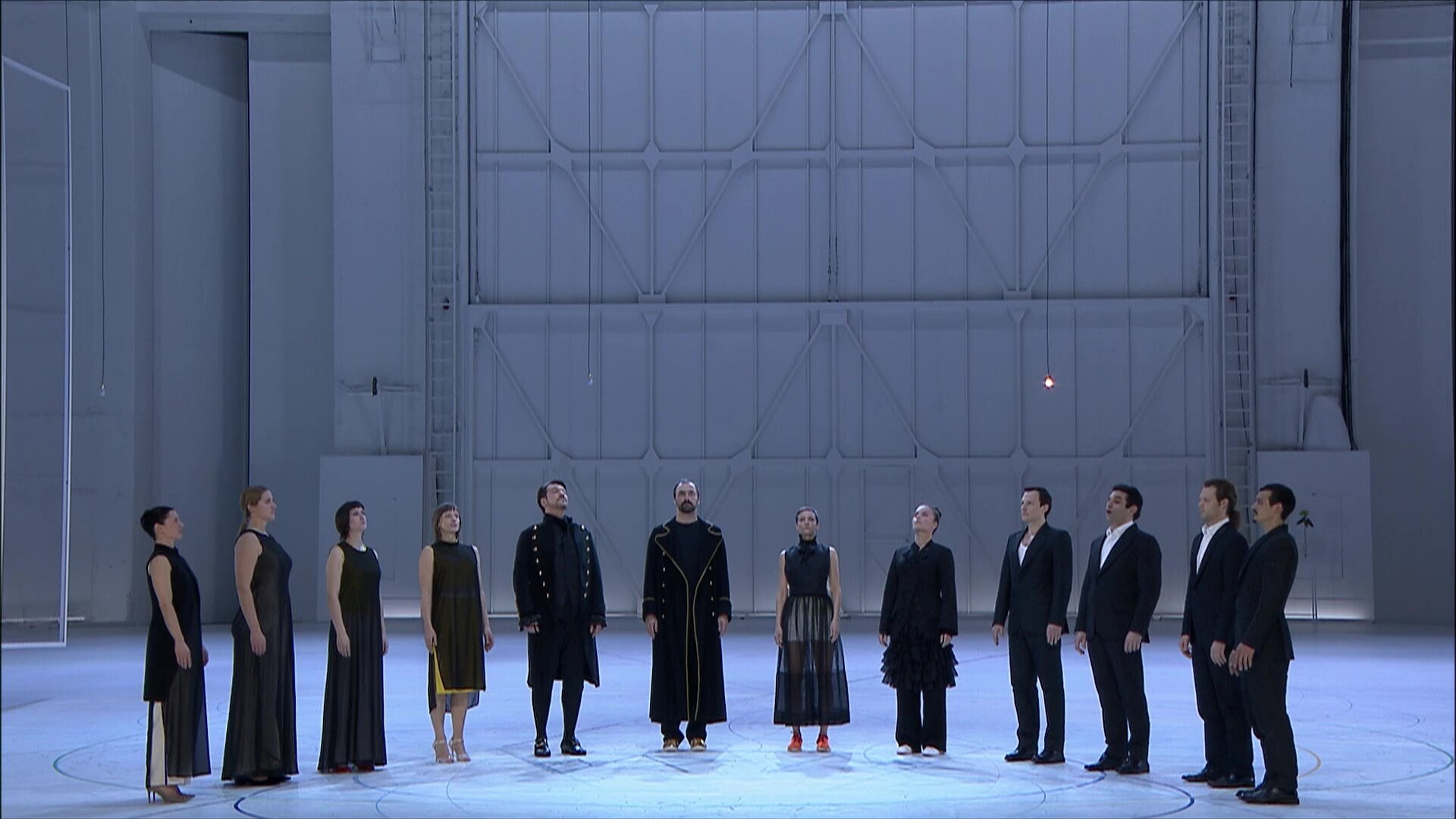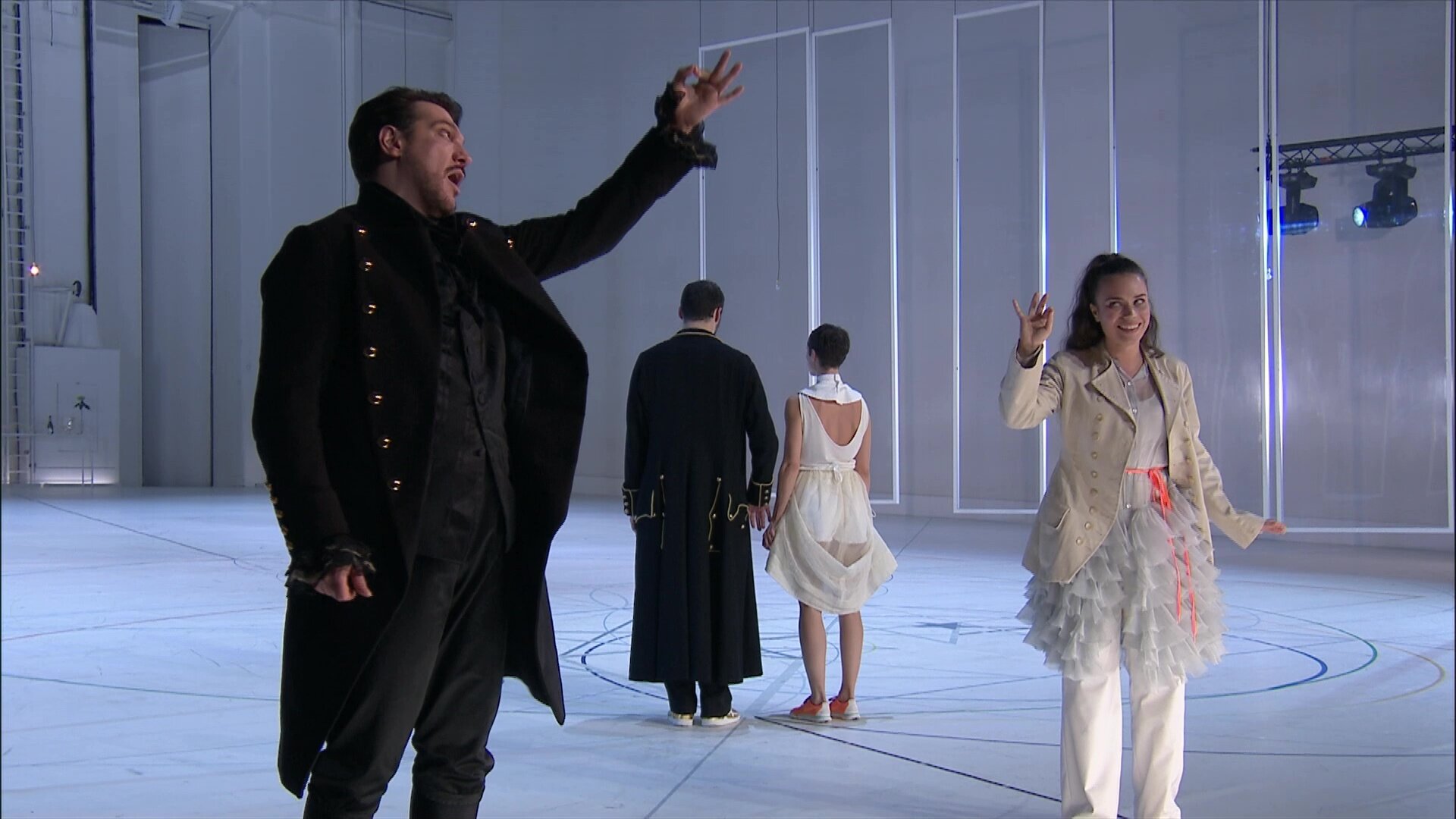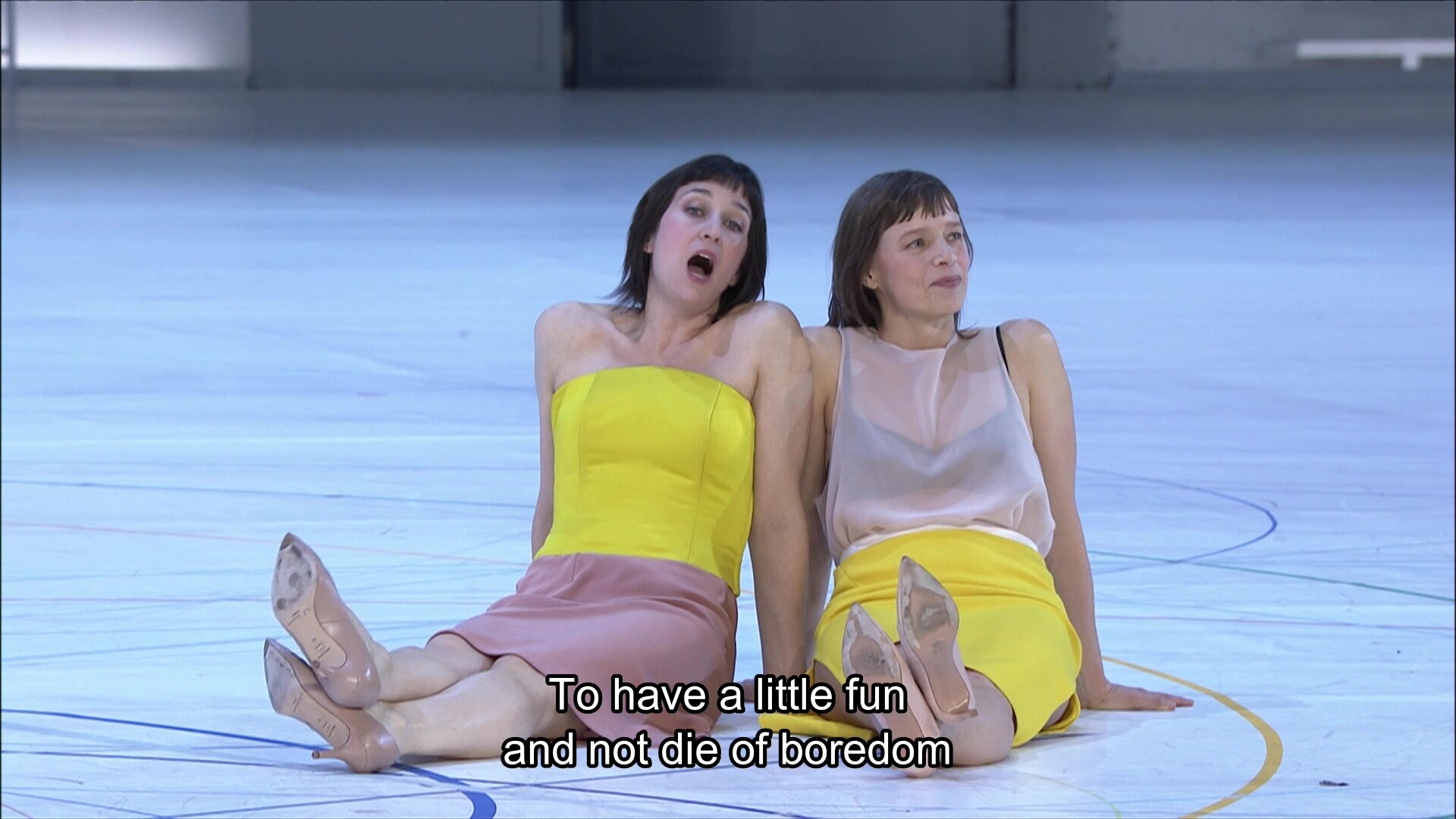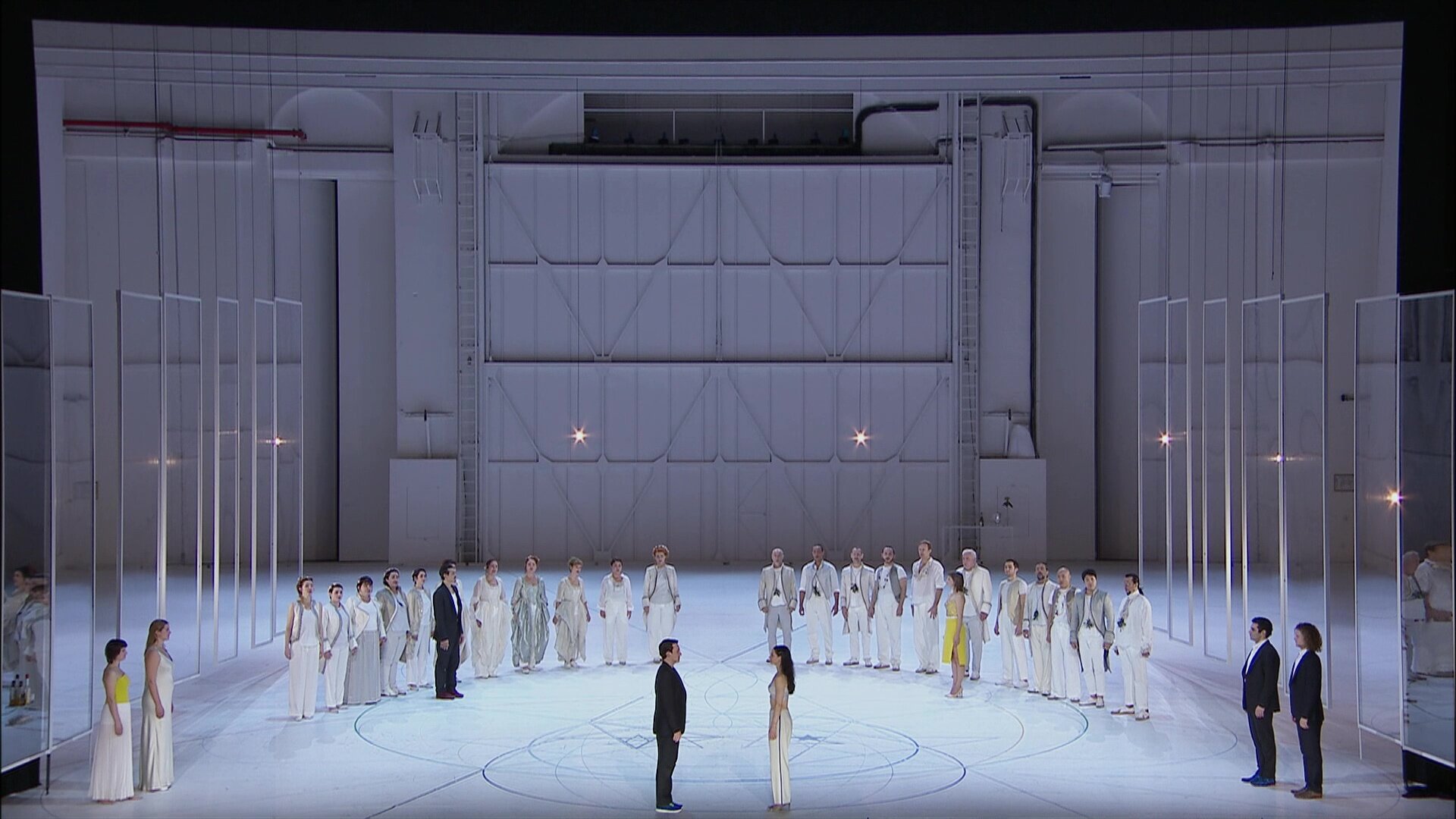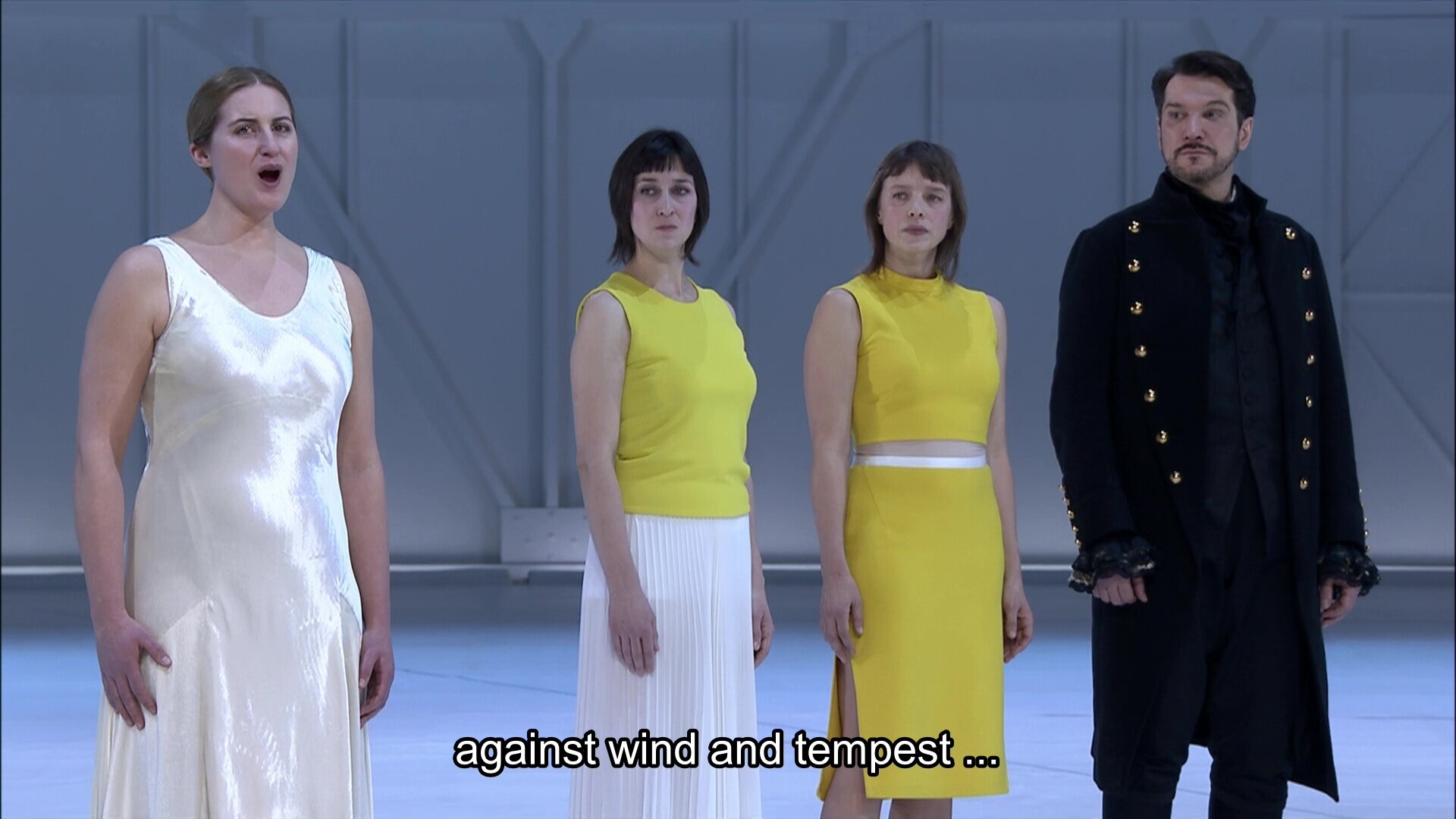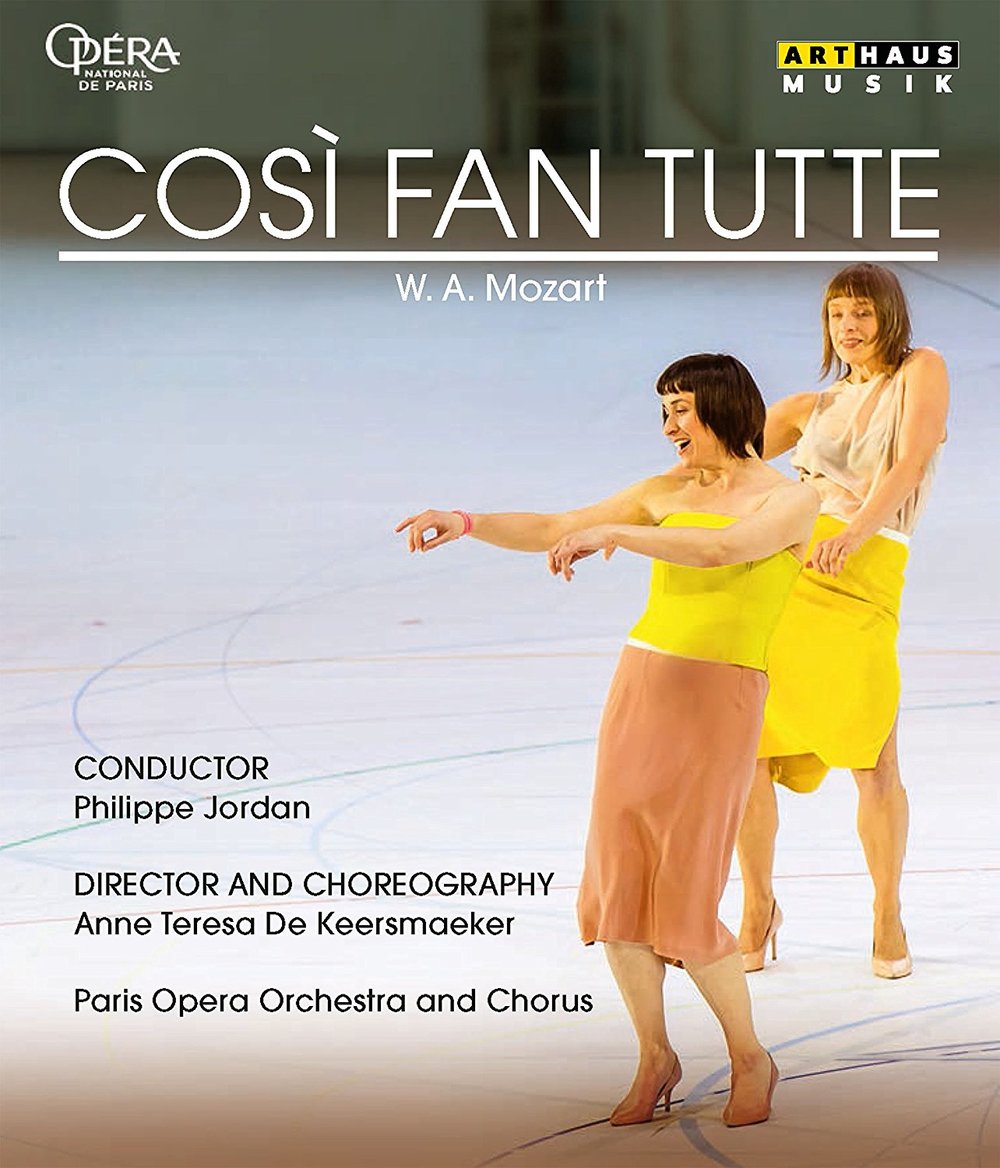
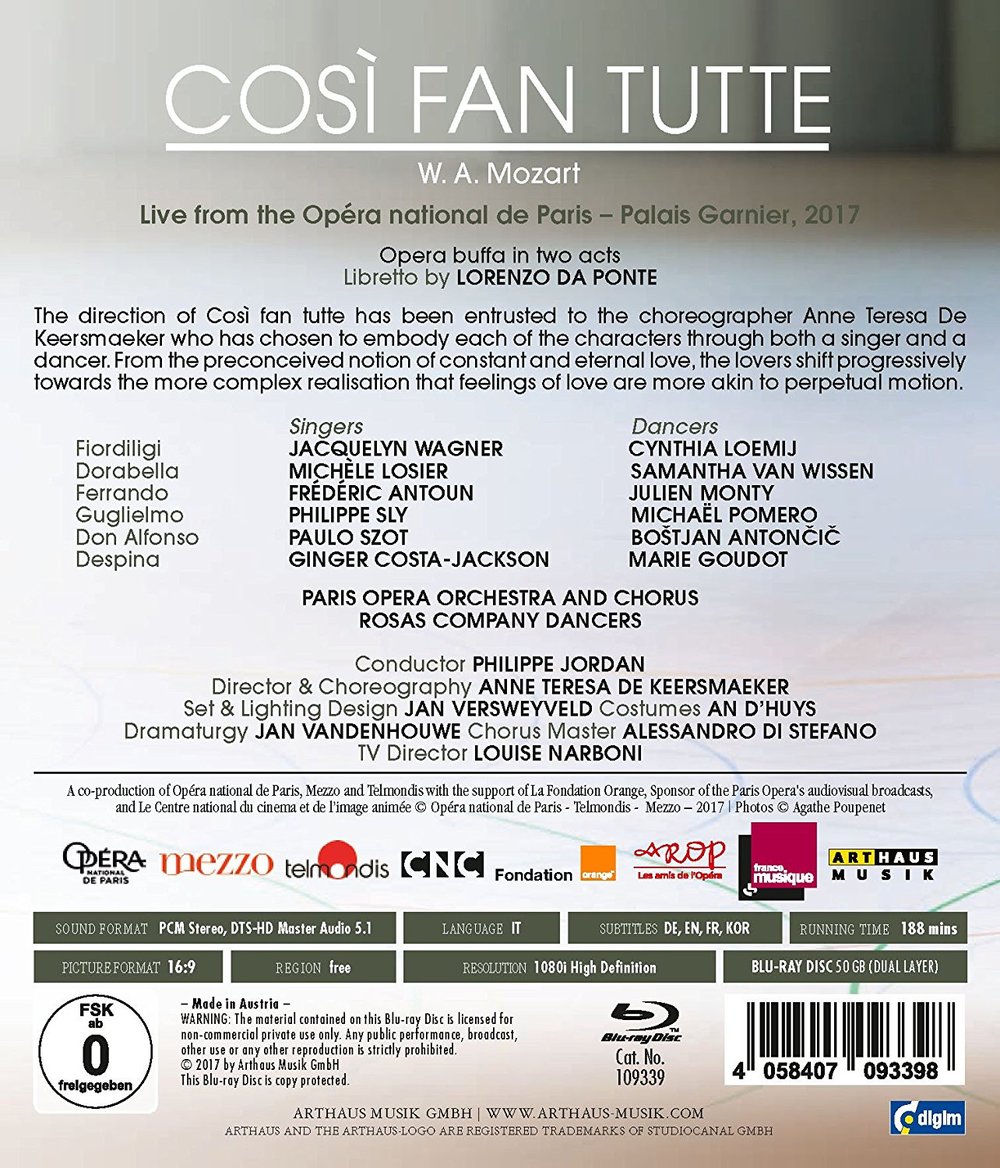
Mozart Così fan tutte opera and dance program to libretto by Lorenzo Da Ponte. Directed 2017 by choreographer Anne Teresa de Keersmaeker at the Opéra national de Paris. Singing stars are Jacquelyn Wagner (Fiordiligi), Michèle Losier (Dorabella), Frédéric Antoun (Ferrando), Philippe Sly (Guglielmo), Paulo Szot (Don Alfonso), and Ginger Costa-Jackson (Despina). The corresponding dancing stars are Cynthia Loemij (Fiordiligi), Samantha Van Wissen (Dorabella), Julien Monty (Ferrando), Michaël Pomero (Guglielmo), Boštjan Antončič (Don Alfonso), and Marie Goudot (Despina), supported by other dancers of de Keersmaeker's Rosas dance company. Philippe Jordan conducts the Paris Opera Orchestra and Chorus (Chorus Master Alessandro di Stefano). Set and lighting design by Jan Versweyveld; costume design by An D'Huys; choreography by Anne Teresa de Keersmaeker; dramaturgy by Jan Vandenhouwe. Directed for TV by Louise Narboni. Sung in Italian. Released 2017, disc has 5.1 dts-HD Master Audio sound. Grade: C-
Così fan tutte is my favorite opera. I wish someone would hire me to translate the libretto into English. I would call it So Do They All with the tagline “(It’s in the nature of women to love, and in the nature of men to lie.)” Ponte’s title has more punch because it blames everything on the two sisters, but my title would support Mozart (the greatest humanitarian in all the arts) in his eventual exoneration of the girls.
Our 1st screenshot below has all the main characters — all dressed in black — from this production in a curve up:
De Keersmaeker as choreographer/director gives each singing character a dancing doppelganger, so now there are 12 people on stage! As much as I love this opera, I always have trouble remembering who is who even with just six 6 characters. Wow: how do I keep a dozen people straight?
It’s important to get the couples Fiordiligi/Guglielmo and Dorabella/Ferrando firmly identified in your mind early on. Then when the great switcheroo in Act 2, scene 2 occurs, you get this terrible feeling in the gut that sets you up for the hilarious scenes to come and Mozart’s generous denouement. But with 12 people on stage, it’s likely you will have trouble keeping track of the players (unless you know Così by heart or you are a genius). If you focus too much energy on who is who, you may have too little energy left for listening to the music and following the plot.
So let’s devote a few screenshots to who is who. In the next image below, Fernando (an army officer) sings of his sweetheart Dorabella. Fernando is sung by Frédéric Antoun shown with his mouth open. To Fernando’s left is Fernando’s dancing double, Julien Monty. To Fernando’s right is Guglielmo, also an army officer, sung by Philippe Sly. To Guglielmo’s right is his dancing double, Michaël Pomero. The men playing Fernando have less hair than the men playing Guglielmo. The libretto says that Fernando is dark and Guglielmo is blond. Well, the singing Guglielmo here is slightly more fair than the singing Fernando:
Now let’s ID the sisters. On the far left is sister Fiordeligi, sung by Jacquelyn Wagner, the tallest of the women. To her right is Dorabella, sung by Michèle Losier. Next on the right is Dorabella danced by Samantha Van Wissen. Then next to the man is Fiordiligi danced by Cynthia Loemij. The singer and dancer for Dorabella often (not always) appear in costumes with some yellow or mustard. The man is Don Alfonso sung by Paulo Szot:
Next below is singer Paulo Szot again as Don Alfonso with his dancing double, Boštjan Antončič on the right:
And finally next below we see Don Alfonso yet again with Despina sung by Ginger Costa-Jackson. In the background is the back of the dancer Don Alfonso. The dancing Don has a longer black coat than the singing Don. Also in the background is Despina danced by Marie Goudot. The singing Despina’s costume always has a ruffled skirt. Despina the dancer always has a longer, transparent skirt:
The Paris Opera management is open to taking chances by bringing in outside modern dance choreographers to work with their ballet. They had a great successes with their Pina Bausch-directed Orpheus und Eurydike, which yielded what I regard as maybe the greatest ballet video ever made. They also did a program called Rain with modern dance maverick Anne Teresa de Keersmaeker. De Keersmaeker is a cerebral proponent of abstract expressionistic dance moves based, she asserts, on scientific (or pseudo-scientific) notions of mathematics and geometry. As part of her brand, she typically paints mysterious geometric figures on the stage floor. In the next screen shot you see the diagram she drew on the Bastille stage floor for this Così. (I have tried with no success to see any connection between this de Keersmaeker diagram or her diagram in Rain with the dancing done on top of them.)
Now is it possible to combine abstract modern dance (usually done as a short piece on a bare stage with instrumental music only plus dramatic lighting and a few odd props) with a 3-hour opera (usually based on an extensive written libretto and sophisticated music expressing a complicated plot in a naturalistic setting of elaborate sets, costumes, and props)? Isn’t this mixing water with oil? Well, in the case of Orpheus und Eurydike the mating was successful because the music was relatively short, the plot simple (three main characters), and the setting is in a cave. But subject title suggests that a Mozart opera is too complicated to to mix well with abstract modern dance.
The opera was not cut much (if at all) and runs over 3 hours. There are some scenes where the dancers added something worthwhile to what the singers were doing. For example see the shot next below where the singing sisters are happy in the background and the dancing sisters amplify this successfully:
And there’s no harm in having your dancing self hanging around keeping you company:
But sometimes the dancers seem to be loitering around as spectators:
And sometimes it’s pitiful seeing dancers trying to guild the lily as in the shot next below. I assert no one could possibly improve on Mozart’s glorious music for Fiordiligi in her great rondo “Per pietà, ben mio, perdona.”
Sometimes a dancer just gets in the way. In the shot below are 7 bodies: all 6 singers plus one dancer trying (unsuccessfully) to get into the act:
Sometimes de Keeersmaeker would recruit singers to join in the dancing — turning Mozart into a musical:
(But I don’t think de Kerrsmaeker ever tried to get her dancers to sing.)
Alas, much of the time what the dancers added to the vast empty stage was just clutter:
We like to have ballet shots that show the whole bodies of all the dancers on the stage. But TV director Louise Narboni couldn’t make a 3-hour video record of distant and offer nearly incomprehensible shots like the 2 above. She tried to salvage something by going in for a lot of close-ups. But with a lot of close-ups, why have dancers on the stage at all?
Well, this was a noble experiment and we should be grateful to all those willing to try something new. But to me it seems there is little coherent choreography in this show. For example, in the next 4 screenshots we see the stage as Fiordiligi sings her famous “Como scoglio” aria. In the 1st screenshot below, the dancing Dorabella just stands there listening:
The camera moves back, and we see all hands on deck (except the two Despinas). First all lean toward Fiordiligi:
Now everybody leans the other way:
And in the 4th shot, they keep leaning more and more until all fall down — is this choreography?
In the next screenshot below, all the characters are back on their feet and form another curve up. H’m — it’s the exact same curve up we saw in our 1st screenshot, except the costumes have changed and we now have yellow light!
Pop quiz: see if you can identify the 12 people in the curve up above. The answer is at the end of the review.
Well, let’s live it up by tightening the curve up to a clump and changing the color of the light. Is this choreography?
Time to sum up and give a grade. All the singers here are young, worthy, and blessed with acting skills as well as fine voices. I would be delighted to watch these singers in a traditional Così. The orchestra and chorus performed for Jordan like their jobs depended on it. PQ and SQ are brilliant. But to get excited about this show, one must be wildly enthusiastic about both abstract modern dance and Mozart operas. Only then would one be able to overlook the incompatibilities in the two art forms made obvious by this production.
There were apparently enough enthusiastic people in France and Belgium to keep this on the boards for a while. But I don’t get it. I have come to love hundreds of operas from my HDVDs. I like modern dancing also. I gave a B+ grade to the Blu-ray of the de Keersmaeker Rain show mentioned earlier. But as suggested in my screenshots, I think the dancing here is inane and distracts from rather that contributes to the opera. I had to grimly force myself to watch this straight through.
Most of the comments I’ve seen from print critics and customers who bought this Blu-ray are unfavorable — but not all. For example, Mark Pullinger (in his review of this at pages 99-100 in the November 2017 Gramophone) notes that the text and music remain (more or less) the same as laid down by Da Ponte and Mozart. But Pullinger also believes that de Keersmaeker choreographs the dancers to act as extensions of the singers and that they manage to show what the singers are really feeling and thinking as plot unfolds. Pullinger concludes "this is a most unusual Così which eventually had me hooked." Well, Pullinger has forgotten more about this opera than I’ll ever know. Perhaps I should just say this is a Così for experts only.
I thought about giving this a D; that is, don’t buy this unless you have a special reason. But maybe that would be too harsh. So I’ll give this a C-. I think there are enough screenshots here for you to judge for yourself whether the dancing is good enough for you to want to buy the disc. Also, attached are 2 official videos which may help you evaluate my sour comments:
Answer to pop quiz: the characters are, from left to right, Fiordiligi dancer, Fiordiligi singer, Dorabella singer, Dorobella dancer, Don Alfonso singer, Don Alfonso dancer, Despina dancer, Despina singer, Fernando dancer, Fernando singer, Guglielmo singer, Guglielmo dancer.
OR
